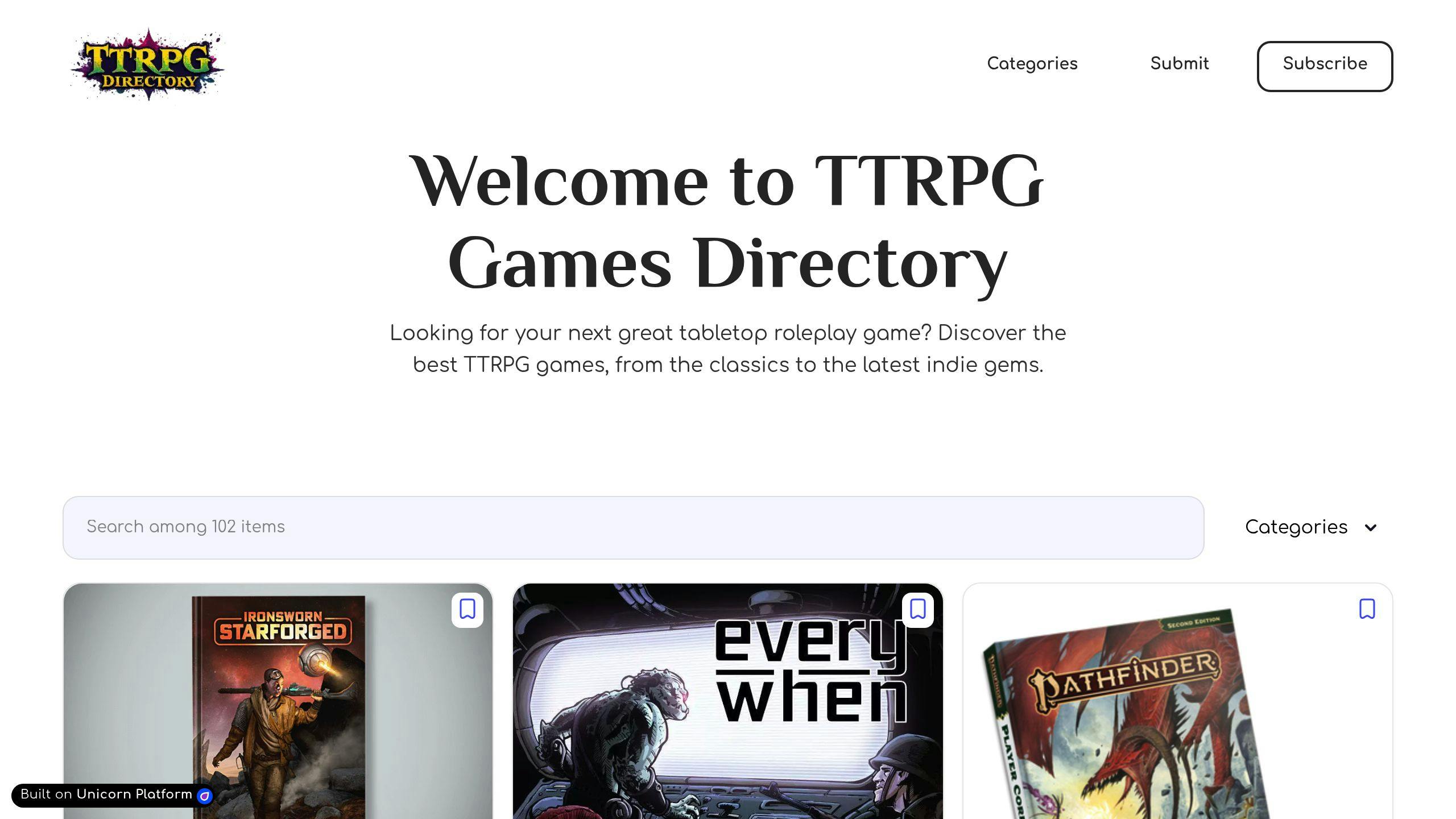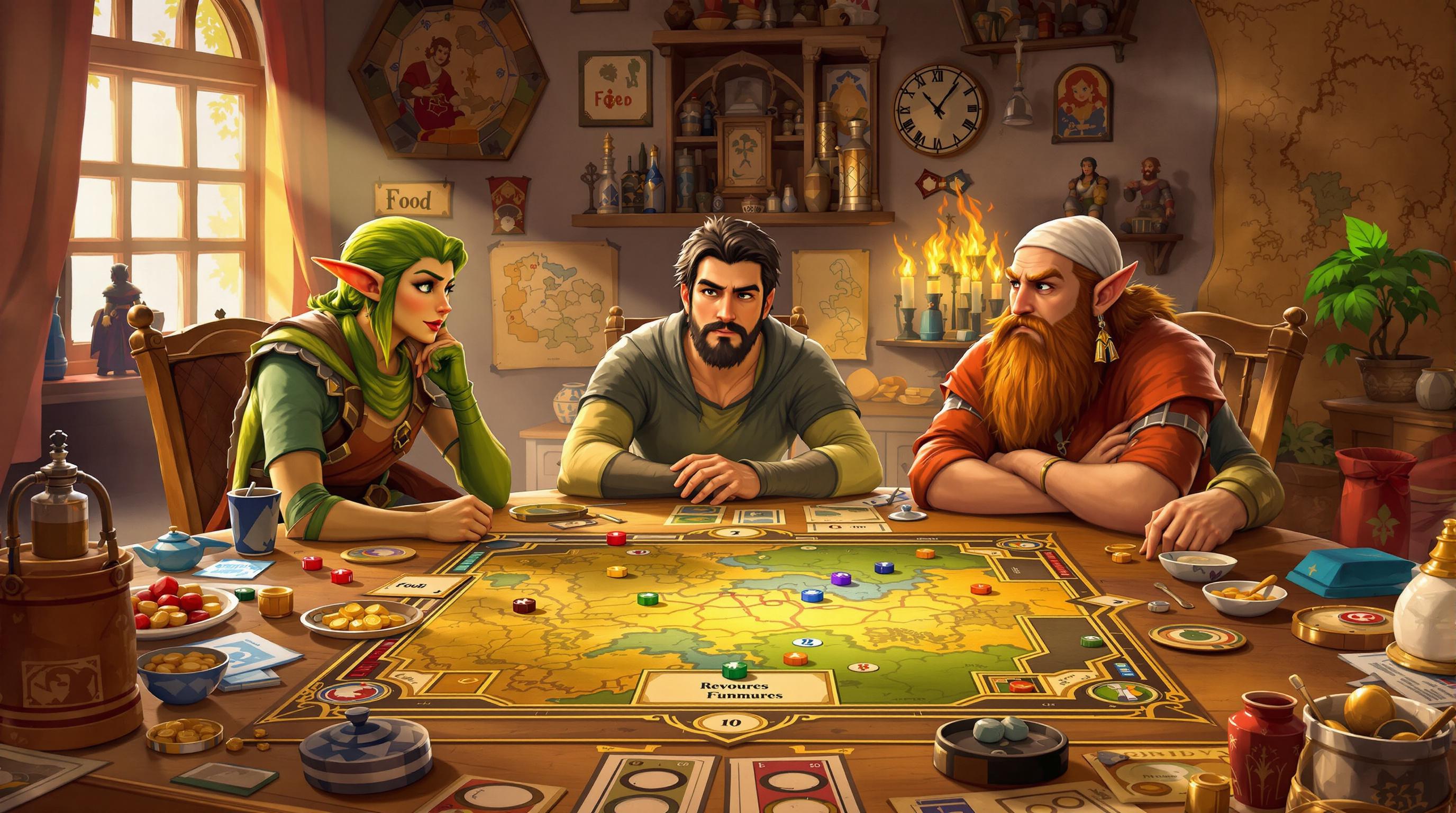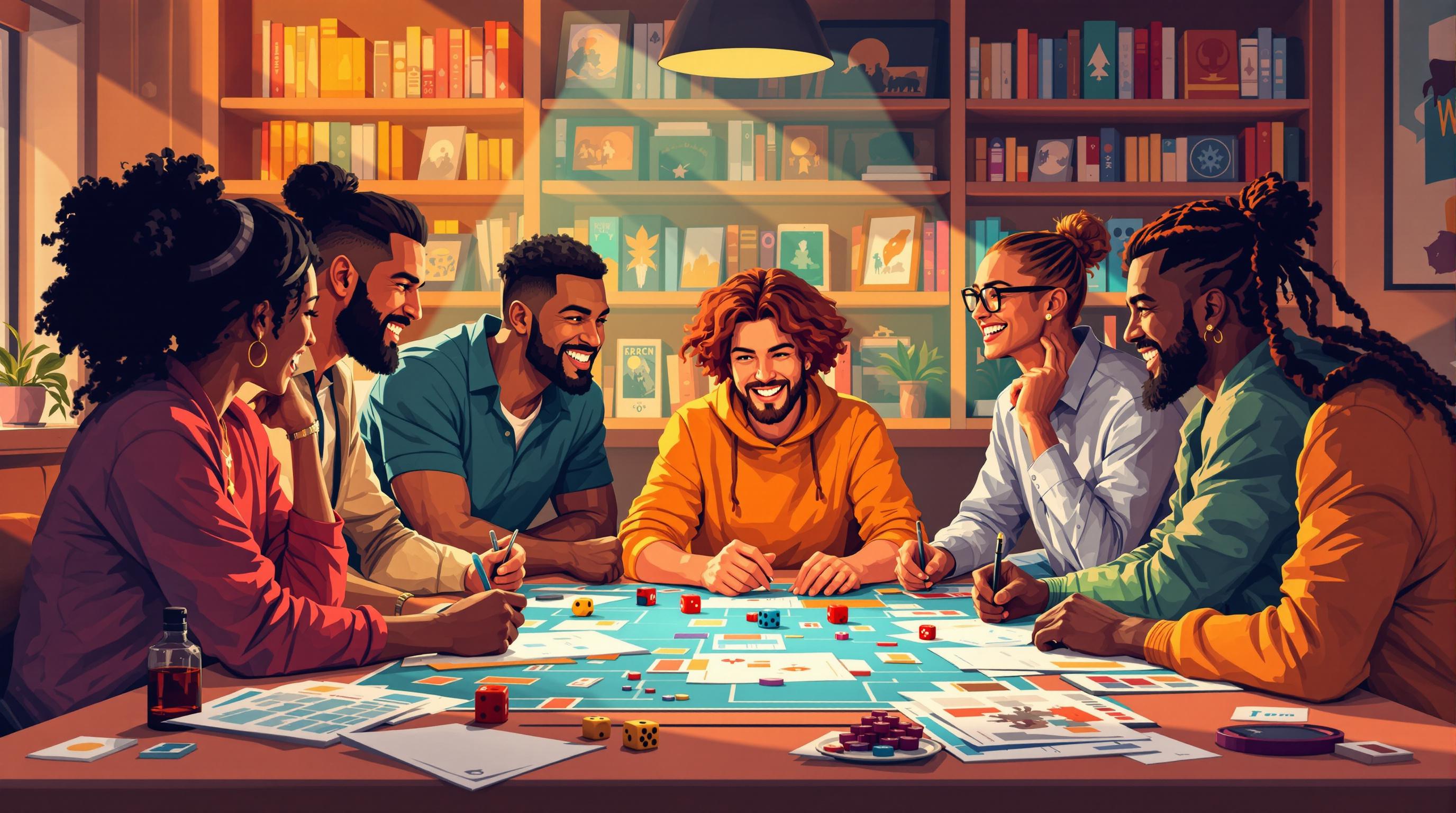NPC relationships are critical for making tabletop RPG campaigns engaging and immersive. Campaigns with evolving NPC connections can last 62% longer and improve player retention by 41%. Here's what you need to know:
- Three Stages of NPC Relationships: First Meetings, Trust and Conflict Growth, and Long-Term Effects.
- Key Mechanics: Systems like D&D 5E's Bonds, Pathfinder 2E's Influence Subsystem, and Monsterhearts 2's String Economy create dynamic NPC interactions.
- Impact of Player Choices: Tools like betrayal mechanics, faction systems, and trust-building systems ensure player decisions have lasting consequences.
- Tracking Tools: Platforms like CampaignLogger and LegendKeeper help GMs manage NPC arcs effectively.
Quick Comparison of NPC Systems
| System | Mechanic | Tracking Method | Unique Feature |
|---|---|---|---|
| D&D 5E | Bonds/Flaws/Ideals | DM Interpretation | Storytelling flexibility |
| Pathfinder 2E | Influence Subsystem | Social Challenges (DC) | Loyalty scale (0 to +5) |
| Monsterhearts 2 | String Economy | Narrative Currency | Emotional leverage mechanics |
| Blades in the Dark | Status Clocks | 0 to 6 Progression | Tracks NPC attitudes dynamically |
| Exalted | Intimacy System | Magnitude Ratings | Integrates social combat |
NPC relationships evolve through meaningful connections, player-driven choices, and structured mechanics. These systems create ripple effects that enhance storytelling and keep campaigns exciting over the long term.
Related video from YouTube
Basic NPC Relationship Systems
Modern tabletop RPGs use detailed mechanics to track and develop NPC relationships throughout campaigns. These systems allow for dynamic interactions that influence both the story and gameplay. They support the three-stage progression mentioned earlier, with mechanics evolving to reflect years of narrative growth.
Types of NPC Bonds
Different RPG systems feature unique types of NPC connections, each tailored to their storytelling needs. For example:
- Familial ties in Dungeons & Dragons often revolve around inherited titles or bloodline-driven plots.
- Faction alliances in Pathfinder rely on reputation tracking within structured groups.
- Professional networks in Blades in the Dark focus on business or criminal collaborations.
- Supernatural connections, like the sire-childer bond in Vampire: The Masquerade, introduce biological constraints to loyalty [2].
Events That Change NPC Relations
Certain events can significantly alter NPC dynamics. Here are key triggers and their effects:
| Trigger Type | System Example | Impact |
|---|---|---|
| Morality Systems | Dragon Age approval meters | Relationships shift immediately based on choices |
| Betrayal Mechanics | Pathfinder betrayal tokens | Triggers automatic hostility |
| Trauma Responses | Call of Cthulhu sanity loss | Trust erodes gradually |
"The Three Connection Minimum rule ensures each NPC maintains meaningful links to at least three others, creating a robust social network that responds naturally to player actions." - Robin D Laws [2]
Managing NPC Conflicts
As relationships grow more complex, managing conflicts requires advanced tools. For example:
- Burning Wheel ties XP rewards to relationship milestones.
- FATE Core uses aspects like "Owed Favor to Duke Marlow", integrating them with its fate point system [4].
- Mouse Guard employs a checkbox system to track emotional states with precision.
About 65% of GMs rely on tools like CampaignLogger to manage relationship arcs across sessions [5]. For longer campaigns, platforms like Obsidian Portal offer visual relationship maps to track evolving connections over multiple storylines [5].
Consistency is key to effective systems. For instance, Lancer RPG uses clear +/-3 modifiers for ally or enemy status, while Numenera employs a 10-point faction scale [4]. These structured approaches ensure that even in multi-year campaigns, early interactions have lasting consequences.
NPC Systems Across TTRPGs
Tabletop RPGs (TTRPGs) offer various ways to manage NPC relationships, each with its own mechanics. These systems range from narrative-driven methods to detailed numerical frameworks, helping Game Masters (GMs) shape long-term campaigns.
System Comparison Table
Here’s a breakdown of how different systems handle NPC relationship mechanics:
| System | Relationship Mechanic | Tracking Method | Key Feature |
|---|---|---|---|
| D&D 5E | Bonds/Flaws/Ideals | DM Interpretation | Focuses on storytelling flexibility |
| Pathfinder 2E | Influence Subsystem | DC 15-30 Social Challenges | Tracks loyalty levels from 0 to +5 |
| Legend of Five Rings | Clan Relations | Honor/Status Points | Tracks political alliances |
| Monsterhearts 2 | String Economy | Narrative Currency | Uses emotional leverage mechanics |
| Exalted | Intimacy System | Magnitude Ratings | Integrates social combat |
For example, Pathfinder 2E uses a structured Influence subsystem where NPCs can progress from Neutral (0) to Devoted (+5) based on social milestones, creating a measurable arc that can span over 15 or more sessions [5].
TTRPG Games Directory: System Guide

The TTRPG Games Directory is a helpful resource for GMs, categorizing game systems by relationship mechanics. Tags like Social Simulation (e.g., Exalted), Faction Systems (e.g., Legend of Five Rings), and Romance Mechanics (e.g., Blue Rose) help GMs find systems that suit their campaign needs.
To simplify choices, the directory organizes systems by complexity:
- Basic: D&D 5E’s open-ended narrative approach
- Intermediate: Pathfinder 2E’s structured Influence mechanics
- Advanced: Burning Wheel’s Beliefs & Instincts, paired with Artha rewards
Each game entry also highlights tools designed for managing long-term social dynamics, making it easier for GMs to plan campaigns.
sbb-itb-b8b00a5
Stages of NPC Relations
Building relationships with NPCs in campaigns unfolds across three main phases, each shaped by core systems previously discussed.
First Meetings
The first encounter with an NPC sets the tone for the relationship's future. In structured campaigns, these introductions often tie into the existing narrative, using elements like faction ties or shared goals to create a sense of connection.
Random encounters linked to backstories can add even more depth. For instance, a merchant recognizing a family crest or a guard captain mentioning shared military history immediately opens up opportunities for a meaningful bond. These small but impactful details often tie into larger narrative themes.
Trust and Conflict Growth
As relationships develop, they begin to influence campaigns in measurable ways:
| Metric | Impact |
|---|---|
| 12-month Player Retention | 41% increase |
| Player-driven Plot Hooks | 2.3x boost |
| PC Turnover Rate | 58% decrease |
Different systems handle trust-building uniquely. For example, Powered by the Apocalypse uses "String" mechanics, where tokens reflect growing influence. On the other hand, Blades in the Dark tracks NPC attitudes through status clocks (ranging from 0 to 6) [4].
Campaign Mastery case studies highlight three common points of relationship tension:
- Betrayals (32% of campaigns)
- Ideological clashes during faction conflicts (28%)
- Resource-based disputes (19%)
These mechanics and crises ripple through campaigns, creating long-term narrative consequences.
Long-Term Effects
Established NPC relationships often leave a lasting mark on the story. For example, in Dragon Age: Inquisition, the death of a romanced noble can permanently block certain political storylines [4][3].
Tracking these impacts is easier with tools like LegendKeeper’s relationship graphs or color-coded indexing systems [3][5].
"Faction forgiveness arcs require triple the effort to rebuild lost trust", says Mike Shea of Sly Flourish, highlighting how damaged relationships can lead to meaningful, long-term challenges [1].
Environmental storytelling also plays a role in reinforcing these stages. For instance, destroyed landmarks in Elder Scrolls serve as lasting reminders of broken alliances [3].
Building Natural NPC Relations
Creating believable NPC relationships requires systems that mimic real social interactions while keeping the campaign's story on track. Long-term campaign mechanics offer various ways to make these relationships feel genuine.
Dynamic World Response
Using interconnected faction systems can lead to ripple effects in NPC behavior. For example, the "Lazy DM" approach assigns each NPC three fixed relationship traits and two flexible slots. This setup allows for storytelling that's both structured and adaptable. When one faction's stance changes, related groups shift their positions too, ensuring the world feels consistent [4][5].
Relationship Mapping Tools
Some tools make managing NPC connections easier. Analog systems like Barker's Rolodex use color-coded cards, while Chartopia's Relationship Generator introduces hidden ties, like a 15% chance of family connections, through weighted tables [3]. These methods balance predictability with unexpected twists, keeping relationships engaging.
Learning from Setbacks
When trust-building efforts fail - such as in 32% of betrayal scenarios - the "fail forward" approach turns those failures into opportunities for new storylines [1]. In longer campaigns, time skips can help reset tensions, with progress clocks visually tracking how relationships recover over time [4].
Examples of NPC Relations
Baldur's Gate 3: Story and Politics
In Baldur's Gate 3, the game weaves politics and storytelling through its faction mechanics. Shadowheart's journey is a prime example: her story unfolds based on approval levels, which can shift her alliances by Act 3. Certain betrayal points lock out political options permanently, creating ripple effects in the narrative. For instance, siding with the Absolute cultists can drastically reshape the campaign's political dynamics [1][4]. This aligns with the betrayal mechanics described in Basic NPC Relationship Systems.
Powered by the Apocalypse: String System
The Powered by the Apocalypse (PbtA) system introduces "strings", a mechanic that turns character relationships into actionable gameplay elements. In Monsterhearts 2, strings allow players to influence others, offering abilities like "Make Them Feel Unwanted" [2][5]. If romantic advances fail, strings transform into "Conditions", which act as penalties until resolved through character growth [4]. This approach reflects the cascading effects described in Trust and Conflict Growth stages.
Dragon Age: Romance and Factions
In Dragon Age, faction relationships are tracked numerically, showing how alliances evolve over time. The 10-point faction scale, referenced in Managing NPC Conflicts, ties directly into campaign results:
| Faction Type | Approval Impact | Gameplay Effect |
|---|---|---|
| Grey Wardens | Below 70% | 35% higher troop casualties [1] |
| Orlesian Nobility | Mixed ratings | Affects war table success rates [5] |
This system highlights how faction dynamics influence gameplay, particularly through war table operations, illustrating the intricate nature of political alliances [5].
Conclusion
The development of NPC relationships in long-running campaigns hinges on progression stages and faction mechanics that create engaging and believable interactions. Research indicates that campaigns with evolving NPC relationships - like those outlined in the three relationship stages - see 62% higher player retention after 20+ sessions [4]. This highlights how essential well-designed relationship systems are for keeping players invested.
Different systems illustrate how mechanics and narrative can work together. For example, rules-light frameworks like PbtA's strings system prioritize flexibility, while structured systems such as Dragon Age's faction mechanics offer clear progression paths. These methods tie directly to trust-building systems and faction scales, as discussed earlier.
Managing NPC relationships effectively requires ongoing effort. Tools like relationship mapping and systematic triggers are key [5]. Time-based tracking systems and escalating consequences allow NPC interactions to evolve organically, reflecting player choices while keeping the story consistent.
Adding depth to NPC relationships pays off. Campaigns with persistent stakes in relationships result in 41% more impactful player decisions [1]. Whether you’re using Dragon Age's faction tracking or Baldur's Gate 3's approval systems, the focus should always be on interactions that grow naturally alongside the campaign.


